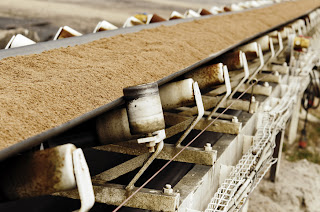Monday, November 18, 2013
Supporting American Made Manufacturing
Monday, October 7, 2013
The Importance of Conveyor Belt Weave Size
 |
| Balanced Weave Belting |
Monday, September 16, 2013
How the Moving Assembly Line Revolutionized the Conveyor Belt
Utilizing four principles (interchangeable parts, continuous flow, division of labor, and reducing wasted effort), the factories began mass produce car parts. To increase workflow, the conveyor belt, a product developed a few years prior was incorporated into production. This process revolutionized the automotive industry and sparked a new relationship between the warehouse and conveyor belting.
Now, in the 100th anniversary year of the moving assembly line, it's safe to say this process put the world on wheels. Car and Driver's piece on the development of this process highlights how the production numbers greatly increased as prices went down—and eventually, the world was on the road.
The conveyor belt assembly line is used in a number of industries, from mining to food processing. As manufacturers of conveyor belting and conveyor belt solutions, we’re proud to work in an industry that has caused so much growth, employment and innovation. For more information on our wire belting and other products, check out our website.
Tuesday, August 20, 2013
How Conveyor Belts Are Suited to Each Food Processing Job
Monday, June 24, 2013
How Can Conveyor Belts Increase Mining ROI?
Monday, June 3, 2013
Recognizing the Importance of Conveyor-Belt Safety

If you’ve ever seen the “I Love Lucy” famous candy factory scene, you know how fast-paced conveyor belts can move. Although it’s funny to watch Lucy and Ethel frantically shove chocolate in their faces to avoid getting fired, those aren’t practices most food processing companies would find acceptable. June is National Safety Month, so we are highlighting the importance of conveyor belt safety.
Ensuring safety for our employees and customers begins before work begins. All conveyor parts are assembled, stabilized, and tested. Safety features such as rails and netting are put in place to protect workers from objects that might accidentally fall off the belt.
The U.S. Department of Labor’s Occupational Safety & Health Administration lays out the safety and health regulations for using conveyors, and here are a few key points:
• Systems must have a stopping mechanism at the operator’s station
• A warning signal must sound immediately before starting up the machine
• Emergency stop switches should not allow the conveyor to start again until the stop has been reset to an “on” position
• Each crossover, aisle, or passageway must be marked with a sign
• If machine isn’t suitable for use, a clear “Do Not Operate” tag must be visible
Furnace Belt makes safety a priority, and we encourage you to check out the video below to learn about the National Safety Council’s Journey to Safety Excellence:
Image courtesy of I Love Lucy's Facebook page
Tuesday, May 21, 2013
Mining Landfills Can Help Save the Environment
Landfill mining and reclamation is a process consisting of excavating and processing solid wastes that are currently in a landfill—in hopes of retrieving space, soil, and recyclable materials. The process, which dates back to the mid-1900s, aides in reorganizing landfills that are poorly operated or are not up to health codes.
Most landfills established prior to 1994 were closed off to seal the waste. In addition, many landfills were developed without linings to separate the landfill and original environment, meaning the waste can seep into the surrounding groundwater, harming land and unleashing legal liabilities.
Mining and reclamation begins by dividing the landfill content and excavating it onto different screens on a conveyor belt—large wastes are caught in the screen while soil falls through the small screen openings. Here is an example of a landfill mining process:
;
This relatively new mining process helps bring the area to an environmental equilibrium, reduce the overall landfill’s size, and recover recyclables. Good candidates for landfill mining and reclamation processes are those where excavators can get an idea of how the landfill was created, the uses of potentially recovered materials, and the current condition of the waste.
Monday, February 18, 2013
A Brief History of Conveyor Belts and the World They Ushered in
 |
| Conveyor belts have a long history as an integral part of production from the coal to the automotive industry. |
Monday, January 28, 2013
Our Work in Open-Pit Mining (Part One of a 2-Part Mining Series)
 |
| All components of a blast furnace must be able to withstand extreme heat. |


